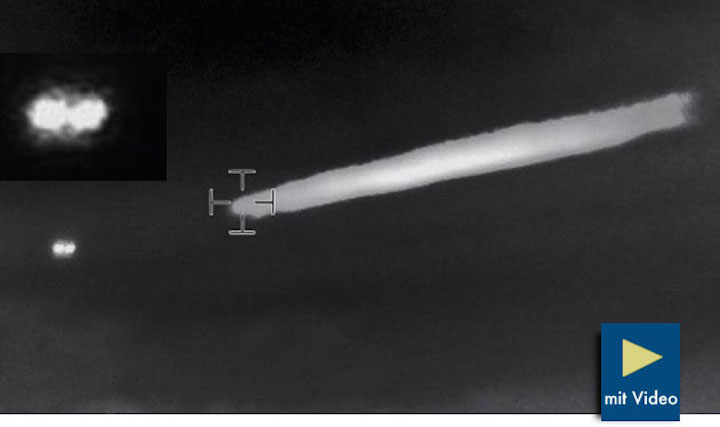.
8.01.2017
Und wieder stellt sich auch im neuen Jahr heraus, private UFO-Forscher bessere Untersuchungen machen als staatliche Stellen, auch wenn dies so manchen Hardcore-UFO-Fans nicht passen wird. In den letzten Tagen wurde über eine Infrarot-Video-Aufnahme von einem militärischen Helikopter der chilenischen NAVY spekuliert, eine UFO-Aufnahme zu haben, für welche es keine natürliche Erklärung gäbe.
Darüber berichtete die Sensations-Presse wie The Huffington Post und hier in Deutschland die Ufologen-Seite Grenzwissenschaften.:
-
Mysteriöses Flugobjekt: Chilenische Regierung veröffentlicht rätselhafte Aufnahmen
Für Ufo-Liebhaber und Verschwörungstheoretiker ist es eine kleine Sensation: Zwei Jahre lang untersuchte die chilenische Regierung ein mysteriöses Video – jetzt veröffentlichte sie das Bildmaterial erstmals. Es zeigt ein nicht identifiziertes Flugobjekt über der Küste im Westen Santiagos.
Das Comité de Estudios de Fenómenos Aéreos Anómalos (CEFAA) beschäftigt sich seit 1997 mit anomalen "Luftphänomenen". Was Helikopter-Piloten der chilenischen Navy am 11. November 2014 bemerkten, stellte die Behörde vor ihr wohl größtes Rätsel.
Die Helikopter flogen auf einer Höhe von über 1.370 Metern, als das Objekt vor ihnen auftauchte. Auf dem Radar war jedoch nichts zu sehen.
Mario Avila, Mitglied der chilenischen Ufo-Behöde, sagte der Huffington Post USA:"Die Navy-Offiziere waren sehr gut ausgebildete Profis mit vielen Jahren Erfahrung. Sie waren sich absolut sicher, dass es keine Erklärung für das gab, was sie gesehen hatten."
Laut einem der Navy-Piloten hatte das Objekt eine "flache, längliche Oberfläche" und zwei Scheinwerfer. Das Objekt habe zudem "eine Art von Gas oder Flüssigkeit mit einer thermischen Spur entladen".
CEFAA-Direktor General Ricardo Bermúdez sagte der Huffington Post: "Wir wissen nicht, was es war. Aber wir können recht gut sagen, was es nicht war“. Eine konventionelle Erklärung für das mysteriöse Objekt schloss er somit zwischen den Zeilen aus.
Die Sichtung sei sein bisher wichtigster Fall als Direktor der Behörde, erklärte Bermudez.
---
So Stand der Dinge der CEFAA, nur kommen erhebliche Zweifel auf, nach dem private UFO-Forscher nach bekannt werden sich der Sache annahmen und schnell herausfanden , es sich in der Nähe des Helikopters Flugbewegungen von Airlinern gab und ein Jet hierfür verantwortlich gemacht werden konnte. Die IR- und normalen Video-Aufnahmen konnten für die Düsen und Contrail des Jet´s identifiziert werden. Da in der Vergangenheit CEFAA in weiteren UFO-Fällen keine Lösung anbieten konnte gegenüber Nachforschungen von privaten UFO-Forschern stellt sich die berechtigte Frage, welche wirklichen UNtersuchungen bei CEFAA statt finden?
Bevor man also Presse-Mitteilungen bei CEFAA macht, sollte man sich vielleicht Hilfe bei privaten UFO-Forschern holen und auf deren Erfahrungsschatz bauen.
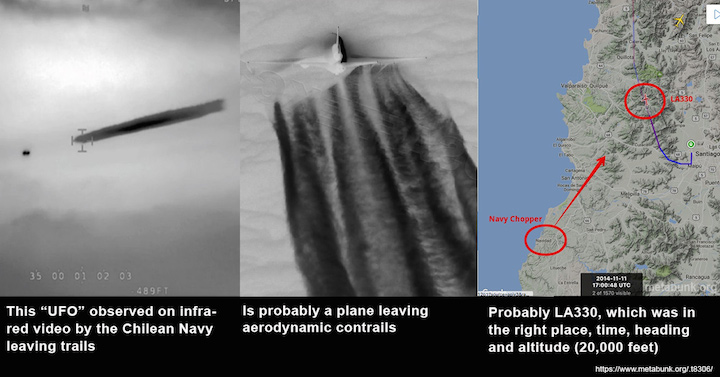
Quelle: UFO Metabunk
---
Update: 6.04.2017
.
Another black eye for CEFAA
The Committee for Studies of Anomalous Aerial Phenomena (CEFAA) is Chile’s answer to the UFO question. This organization, under the leadership of General Ricardo Bermudez (and now Jose Lay), has promoted quite a few cases in the past decade that they consider evidence of something unknown being visible in the sky. Most notable was the 2012 El Bosque air show videos (See SUNlite 4-3), which Leslie Kean had considered to be the kind of evidence that skeptics feared. That video did not survive scrutiny by skeptics, who demonstrated that the UFOs were nothing more than bugs. There were other cases that were promoted and found to be suspect as well.1 Needless to say, CEFAA’s track record for fully investigating such cases was already suspect when Leslie Kean publicized another video showing something they had investigated and could not explain. To CEFAA and Kean it was something exotic.
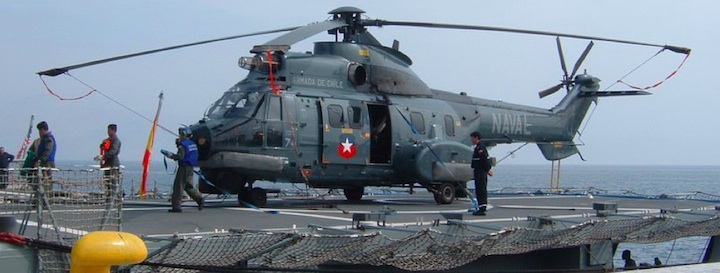
The case as presented
The case involved an infrared video shot from a Chilean Navy helicopter. On November 11, 2014 While traveling north, the he- licopter recorded an “unusual” object with two, or more, heat sources. It emitted some sort of exhaust towards the end of the video. Unfortunately, there was no formal report presented by CEFAA and we only saw a press release and two articles written by Leslie Kean and Jon Austin.
According to the Austin article, the event was investigated for two years by CEFAA. The helicopter crew attempted to see if there were any aircraft in the area and there was nothing detected on the helicopter’s radar. Further inquiries revealed that there were no radar contacts in their vicinity and no aircraft in the area.
CEFAA reported they had eight meetings with experts and they all had concluded that they could not explain it. Bermudez was impressed with the results and stated, “This has been one of the most important cases in my career as director of CEFAA because our committee was at its best.”2

The CEFAA press release added3:
-
The officers contacted the Air Traffic controllers and they stated they had no objects on radar.
-
They tried to contact the object but it did not respond
-
The FAA radar confirmed that there was no unauthorized traffic in the vicinity of the helicopter.
-
The object disappeared into the clouds.
In Kean’s article, some additional details were revealed4:
-
The crew saw the object over water
-
The crew estimated the object was 35-40 miles (55-65km) away and it was traveling West-Northwest.
-
Over nine minutes elapsed before the object disappeared into the clouds.
-
At the end of the video, there appeared to be an unusual emission from the object, which a technician referred to as, “...some type of gas or liquid with a high thermal track or signal”.
Kean then stated that Francois Louange and his group were contacted for analysis. They suggested the object was just an aircraft getting ready to land at Santiago airport. The emission was just dumping of cabin waste water. CEFAA disagreed because:
-
The aircraft would have been seen on radar
-
The aircraft would have been known to exist because it would have been clearance to land
-
The aircraft would have responded to radio from the helicopter.
-
Aircraft are not authorized to eject waste water prior to landing.
-
The experienced helicopter pilot would have recognized it as an airplane.
Kean was ecstatic about the article’s reception and proclaimed to her followers that the story had 700,000 views in just a few days.5 To CEFAA and Kean, it seemed like a pretty good case but I had to wonder exactly what CEFAA found so convincing about it because, at first glance, it looked like an aircraft and contrail.
IPACO’s analysis
The reference to a study by Francois Louange appears to be the report submitted to CEFAA by IPACO from November of 2015. It involved Louange, Geoff Quick, and Antoine Cousyn. Shortly after the
story appeared, IPACO released the report on their web site. According to
Cousyn, CEFAA really did not provide them a lot of information other than
the video. They had to guess at what type of IR systems was used, which they got wrong, and they were not supplied with any information they re- quested.
Their conclusion was as described by Kean but they supplied the data in their report that explained some of the objections raised by CEFAA6:
Concerning detection, could it be that Air traffic ground controllers were look- ing too close to the helicopter for a radar return, discounting that of the airlin- er as being too far away to the North?
Concerning radio communication, could it be that the jet was not monitoring the frequencies or did not think it was them being interrogated (“Can’t be for us, we are too far North”)?
(Note: this type of incident has already been experienced on many occasions.)
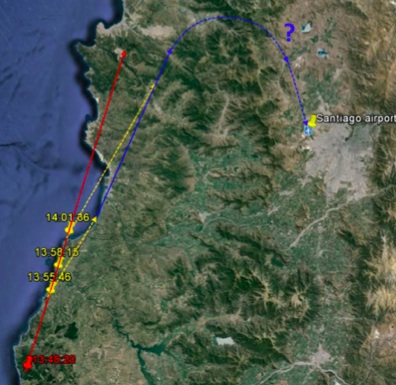
After the release of the report, Chris Isbert played the role of devil’s advocate in Gille’s Fernandez Facebook group, UFO Pragmatism. He found problems with the aircraft landing hypothesis. He felt the plane would not have taken the approach, using the altitude assumed by IPACO, because of the mountains in the region. It appeared that the IPACO hypothesis was not adequate to explain the video and more information was needed.
Metabunk to the rescue!
Mick West is the moderator for the Metabunk forum and his group had an interest in this video7. They apparently felt the same way I did and thought it looked like an aircraft with a contrail. Like the Roswell slides, their discussion of the case was an excel- lent example of collaboration between various individuals, who worked together to achieve the common goal of finding the source of the object. One of the group, by the name of trailblazer, used planefinder.net and determined that there were aircraft in the area of interest at the time of the sighting. One was a four-engine jet (Flight IB6830 leaving Santiago airport for Madrid, Spain) and the other was a twin-engine airliner (Flight LA330 leaving Santiago airport for Antofagasta). Both were in the direction the FLIR was looking when the object had been recorded showing a contrail.

Because of the IPACO analysis suggesting the aircraft had two engines, flight 330 was the obvious candidate and initial analysis had the plane’s path line up with the last segments of the video. However, in our Facebook group discussion, Chris Isbert disagreed with this analysis because there were some problems with using the twin-engine airliner. The plane was not airborne until after the craft had been recorded on the video. This left the four-engine jet as the only other possibility. A potential indicator that the flight 6830 was the culprit was when the object was first recorded, it appeared to be in a bank to starboard. About the same time, flight 6830 was making a turn to starboard to change its flight path towards the North-Northeast. There were reasons for being hesitant to accept the 6830 candidate. Except for the first part of the recording, where the object looked like several blobs close together, the object appeared to have only two heat sources. As IPACO stated, this indicated that the craft was a twin engine jet and not a four engine craft. Others felt that the contrail did not look correct for the path of the aircraft. Faced with these conflicts, Mick proposed that the original UAP was the four-engine aircraft. When the operators cycled through the various modes, they had lost track of flight 6830 and then picked up flight 330 which was now in the same region of the sky. This hypothesis did not last either as problems were discovered. This brought everyone back to flight 6830. After further review, it was determined that the contrail appearance did match flight 6830’s track and the four engines would appear as two sources at the distances involved. This became the final hypothesis and further testing began to confirm this explanation.
At this point, the CEFAA apologists began to question the explanation because “the debunkers” could not agree on which plane was the source. This was really unfair because they were reading an open discussion where various possibilities were being exam- ined and eliminated. The group did come to a final conclusion within a few days and any criticism of how the group examined the various hypotheses was unjustified.
The only arguments against the flight 6830 explanation were:
-
CEFAA investigated for any aircraft in the region and found none.
-
CEFAA stated that there were no targets on radar in the area.
CEFAA would not miss this explanation after two years of investigation and analysis by experts.
These arguments did not carry much weight. The existence of flight 6830 was A FACT and two of these arguments were refuted by this. It appears that the radar/FAA records line has been misconstrued by the promoters like Leslie Kean. One must remember
that the CEFAA press release makes reference to radar and aircraft WITHIN THE VICINITY OF THE HELICOPTER and not over the entire region. The closest 6830 was to the helicopter was about 50 miles.
Mick West provided a graphic (see above) that demonstrated that flight IB6830 was most definitely the source of the image in the video. It shows the object receding in the distance the same way the aircraft would have and the orientation was correct. In the words of Mick West:
These are verifiable facts that I (and others) simply discovered. Unless there was a UFO flying between the plane and the helicopter, mim- icking the motion, the banking, the size and the thermal signature of the plane, then it’s a plane.8

The case was solved.
Ignoring the obvious
Leslie Kean had been made aware of the aircraft hypothesis early in the discussions when flight A330 was the initial candidate
7 and responded :
There are many holes in this flight LA330 hypothesis. First and foremost is that the Chilean authorities would have easily determined this to be the explanation if indeed it were. They had access to all aviation data, obviously. Their goal was to find an explanation if possible. I’ll be back with more.9
As the explanation became more solid, others began to inform Kean of the debunkers claiming victory and her case was “unravel- ing”. Kean, once again, responded:
“...I just contacted them. It has NOT unravelled and has not been solved. I will be providing more info soon.”10
This was the kind of response Kean gave when she was caught promoting CEFAA’s videos of bugs as the case skeptics were dread- ing. It appeared that Kean had to ask CEFAA how to think about this case instead of personally evaluating West’s explanation.
Meanwhile, Kean continued to promote the case. She went on Open Minds with Alejandro Rojas and never bothered to mention the potential explanation. Rojas, who mentioned the expla-
nation prior to the interview, avoided discussing it as he
threw softballs for Kean and Jose Lay. It seems that nobody
wanted to admit the skeptics might be right.
During the interview with Rojas, Lay mentioned that the UAP had disappeared over the Pacific ocean11. Writing on Kean’s Facebook page, James Oberg pointed out to her that the UAP was over land. Kean’s response was:
The two Navy officers saw the object off the left side of the aircraft, flying N/NW. They were going up the coast along the ocean; the object was some distance away over the ocean.
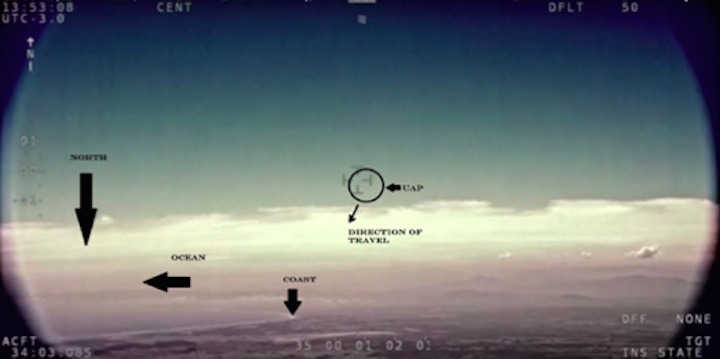
The French report placed the object to the right of the chopper, but this was inaccurate.12
The comments by Kean and Lay made me wonder if they had even watched the video. They seemed to be completely clueless about what was obvious to everyone who examined the video. With this kind of “research” is it any surprise they did not want to admit the skeptics/debunkers might be right?
Crediting the wrong people
On the 17th of January, almost two weeks after her original article, Kean caved under the overwhelming evidence that had been
13 accumulated. She wrote another story for the Huffington Post with the title, “The Chilean Navy UFO Video: Is It A Plane?”
In that article, Kean, snubbed the work of Mick West, and others, in order to promote MUFON’s Robert Powell as the person, who solved the case. Apparently, Powell asked her to provide the radar data from CEFAA, after she published her story, and he then cor- rectly identified the IB6830 aircraft. It is odd that CEFAA had claimed that no aircraft were in the region and radar data had verified this. Now we see that there were aircraft in the region and CEFAA had ignored them because they weren’t close enough. Apparently, these aircraft “experts” felt that nobody can see aircraft in a clear sky from such a distance. They seemed to be clueless as to what was possible with the instrument they were using.
Of course, Mick West, and his group, had already done all of this work on Metabunk (having resolved the case within 96 hours of the story first being published), which Kean chose not to mention. Kean also gave some credit to Rob Jeffs for identifying an error in the system of about 7 degrees azimuth. He apparently used the same methodology used by Chris Isbert and myself on Facebook. Mick West had done this indirectly when he matched frames from the video with the land features. He never identified a specific value of an offset but the images demonstrated there was one. I have no idea if Powell and Jeffs were using the initial work done by West or not but, based on Kean’s publication date for this information, they had apparently arrived at their conclusions well after Metabunk had done so. Otherwise, Kean never would have stated that the case was not unraveling or that it was not an airplane four days after she published her initial story!
Not only did she not give ‘debunkers” any credit, Kean tried to portray their work as sloppy and unscientific:
Since this widely distributed story broke, people using social media and blogs have taken it upon themselves to solve this case in a matter of days, and with minimal information. These platforms have presented arguments without properly developing them, and in some cas- es people with prior agendas have made derogatory, sometimes inaccurate statements that do not facilitate cooperative relationships between CEFAA and those seriously interested in the case... I hope that those who wish to contribute to the further understanding of this case will present their findings in papers that can be studied properly, rather than in quick, superficial examinations on blogs or by issuing uninformed and disrespectful opinions on social media. We all have to step back for a while, because proper investigations take a long time.14
I find it interesting that Kean did not reveal the radar data in her original article even though she had access to it. Had she done that in the first place, flight 6830 would have been obvious to eagle-eyed observers. Is this a case of CEFAA/Kean trying to conceal information from the public or just another example of CEFAA’s incompetence?
Embarrassed by being shown to be wrong again, Kean went after debunkers by quoting Robert Powell’s criticism about groups having to submit papers for evaluation prior to announcing a case is solved. This is amusing because Powell published no paper and neither did CEFAA.
This became even more amusing when Kean revealed that CEFAA was not a true “research organization” and was not required to submit any reports for review:
The staff there do not spend time putting together long reports after conducting an investigation, because this is not something that is needed for the work they do. They collect the data and rely on committee members from many disciplines to provide their views, which usually takes a long time. Much of the work is done during discussions at lengthy meetings. At the end, they simply move on. The agency is not a research organization. It is not mandated to provide reports for UFO investigators in other countries, nor does it have the time or interest to do so.15
I thought CEFAA and GEIPAN had an agreement to exchange information about their cases.16 How can they exchange information if they don’t write formal papers/reports? Kean has also referred to this group as the CEFAA scientific committee in her original ar- ticle.17 Now she implies that what they are doing is not science and they don’t write formal reports. All they apparently do is have meetings to discuss these cases and issue press releases. If this is accurate, it is no surprise that CEFAA continuously fails at analyzing these videos.
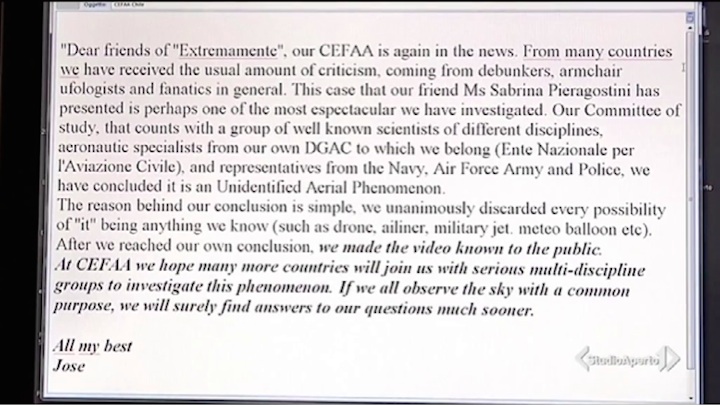
What is wrong with CEFAA?
CEFAA continues to promote these cases that can be identified by others because they appear to be taking an incorrect approach to these videos. The old phrase “If it looks like a duck...” comes to my mind. This video looked a lot like an airplane with contrail, which means there is a good possibility it was. CEFAA clearly had all of this information available to them but has refused to explain why they ignored the possibility of it being an aircraft. Since there is no formal report we have to speculate.
I believe CEFAA put too much weight in the report by the aircrew of the helicopter. It was mentioned several times that the UAP flew over water towards the North-northwest. Jose Lay even stated it headed out over the pacific! However, the video clearly shows it going towards the North-northeast and heading over land. This inaccuracy indicates to me that they ignored the video in favor of what the aircrew had stated in the reports they filed sometime after the event. If they put that much weight into that statement, then they probably considered the estimated distance made by the aircrew was 100% accurate. This would lead them to limit their search for a potential explanation to a confined radius around the helicopter. IB6830 would have been outside that radius since the closest it came to the helicopter was about fifty miles. I expect this sort of thing from some UFO groups but not an organization, involving experts, that spent two years discussing the case.
If a scientific organization (or any business for that matter) fails at something, the first thing to do is look inward and try and correct what went wrong. CEFAA apparently chose not to do this and, instead, looked outward to find fault. Jose Lay, the new director of CEFAA, tried to make it appear they made an exhaustive effort and that “debunkers, armchair UFOlogists, and fanatics” were wrong in their criticism.18 One would think he would have thanked people like Mick West and apologized for their mistake. Instead, the director of CEFAA acted like nothing was wrong.
CEFAA’s motivations may be interfering with them examining such cases. One has to remember that their purpose is to investigate UAPs and determine if they pose a hazard to aviation. If UAPs, like this one, can be explained, they are demonstrating that UAPs pose no hazard or threat. If enough cases are shown to be explained, somebody in the government is going to start wondering why they have such an organization and cut their funding. As a result, there would be no CEFAA and some people might be out of a job. CEFAA’s motivation may be more about job security and less about doing a good job.
What next?
I think this case provides another example of why organizations dedicated to studying UFOs/UAPs continuously make mistakes. They are motivated to present cases that are unexplained and not motivated to explain them. Those that promote these organiza- tions, like Leslie Kean, are going to ignore the failures in favor of the publicity they receive when they can write about the latest “best case”. What Kean, and her fellow promoters, fail to realize is that they have a responsibility to perform their own due diligence on the case before promoting it. Since Leslie Kean did not vet the case properly, CEFAA’s failure is also hers.
Quelle: SUNlite 2/2017

